Organisational Barriers for Women Leadership in Healthcare Sector
VerifiedAdded on 2023/01/16
|14
|4896
|81
Essay
AI Summary
This essay explores the organisational barriers that hinder women's leadership in the healthcare sector within developed countries. It begins with an introduction highlighting the increasing participation of women in healthcare, the underrepresentation in leadership roles, and the prevalence of gender stereotypes. The literature review covers the challenges women face, including stereotypes, societal expectations, and organizational factors. The essay examines the impact of these barriers on women's performance and career progression, as well as the implications for healthcare quality and service delivery. It further investigates strategies to overcome these barriers, such as legislative reforms, promoting gender diversity, and enhancing flexible working opportunities. The essay discusses the importance of providing equal opportunities for women leaders to improve healthcare services and meet community needs. The research questions, aim, objectives, scope, and significance are outlined, and the structure of the dissertation is provided. The essay also touches upon organisational models and provides examples of how these models affect women's leadership, followed by a discussion of the literature gaps and potential solutions.
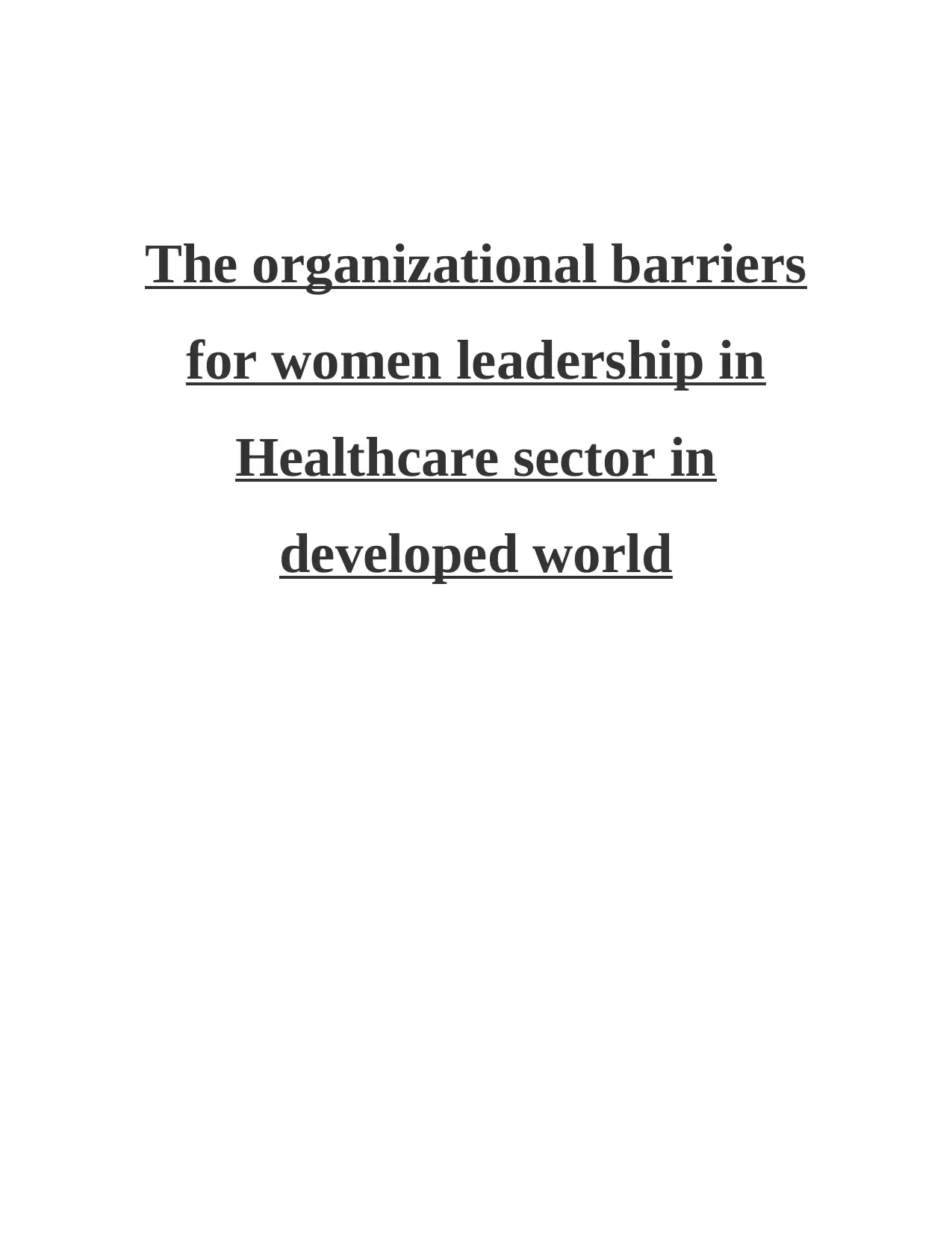
The organizational barriers
for women leadership in
Healthcare sector in
developed world
for women leadership in
Healthcare sector in
developed world
Paraphrase This Document
Need a fresh take? Get an instant paraphrase of this document with our AI Paraphraser
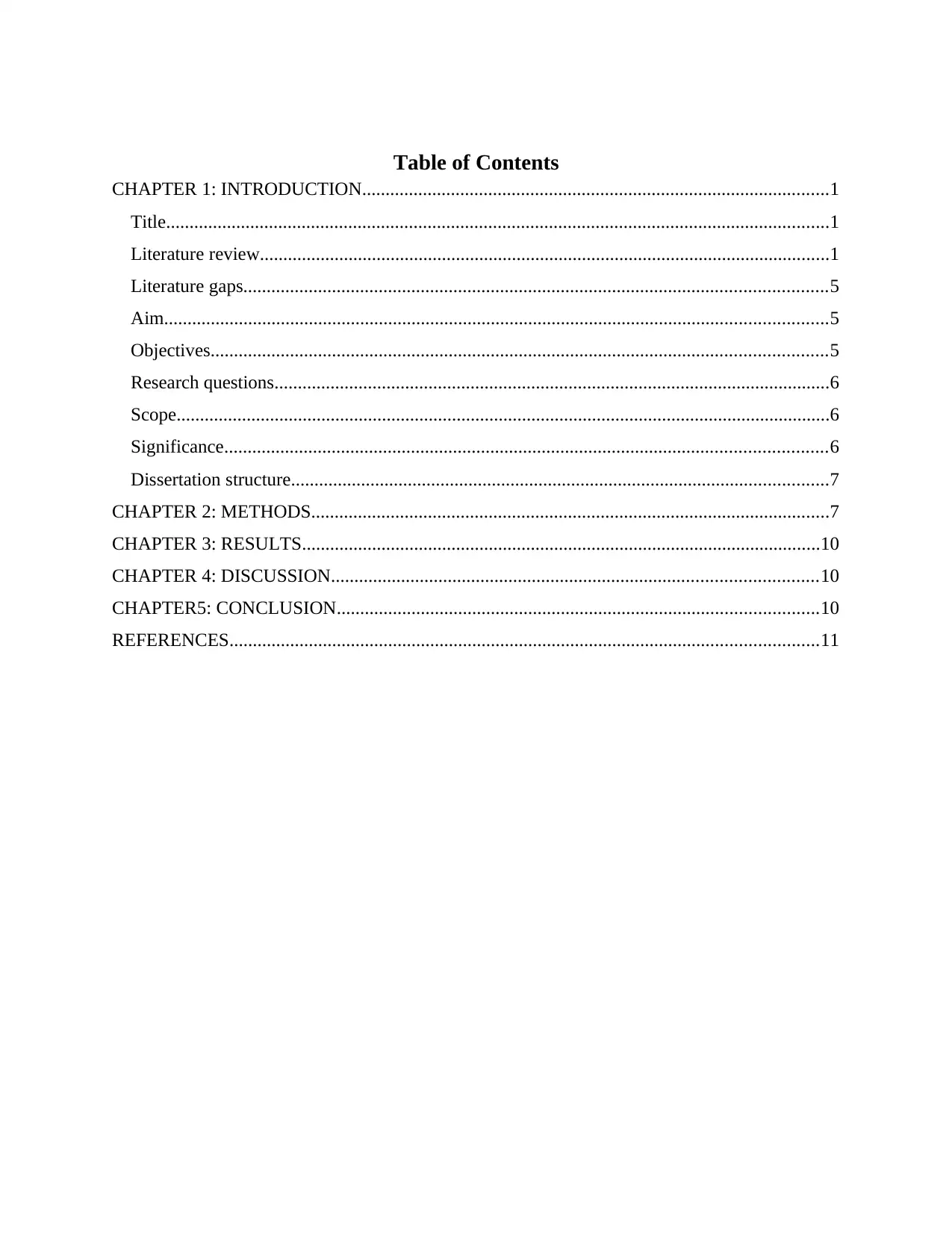
Table of Contents
CHAPTER 1: INTRODUCTION....................................................................................................1
Title..............................................................................................................................................1
Literature review..........................................................................................................................1
Literature gaps.............................................................................................................................5
Aim..............................................................................................................................................5
Objectives....................................................................................................................................5
Research questions.......................................................................................................................6
Scope............................................................................................................................................6
Significance.................................................................................................................................6
Dissertation structure...................................................................................................................7
CHAPTER 2: METHODS...............................................................................................................7
CHAPTER 3: RESULTS...............................................................................................................10
CHAPTER 4: DISCUSSION........................................................................................................10
CHAPTER5: CONCLUSION.......................................................................................................10
REFERENCES..............................................................................................................................11
CHAPTER 1: INTRODUCTION....................................................................................................1
Title..............................................................................................................................................1
Literature review..........................................................................................................................1
Literature gaps.............................................................................................................................5
Aim..............................................................................................................................................5
Objectives....................................................................................................................................5
Research questions.......................................................................................................................6
Scope............................................................................................................................................6
Significance.................................................................................................................................6
Dissertation structure...................................................................................................................7
CHAPTER 2: METHODS...............................................................................................................7
CHAPTER 3: RESULTS...............................................................................................................10
CHAPTER 4: DISCUSSION........................................................................................................10
CHAPTER5: CONCLUSION.......................................................................................................10
REFERENCES..............................................................................................................................11
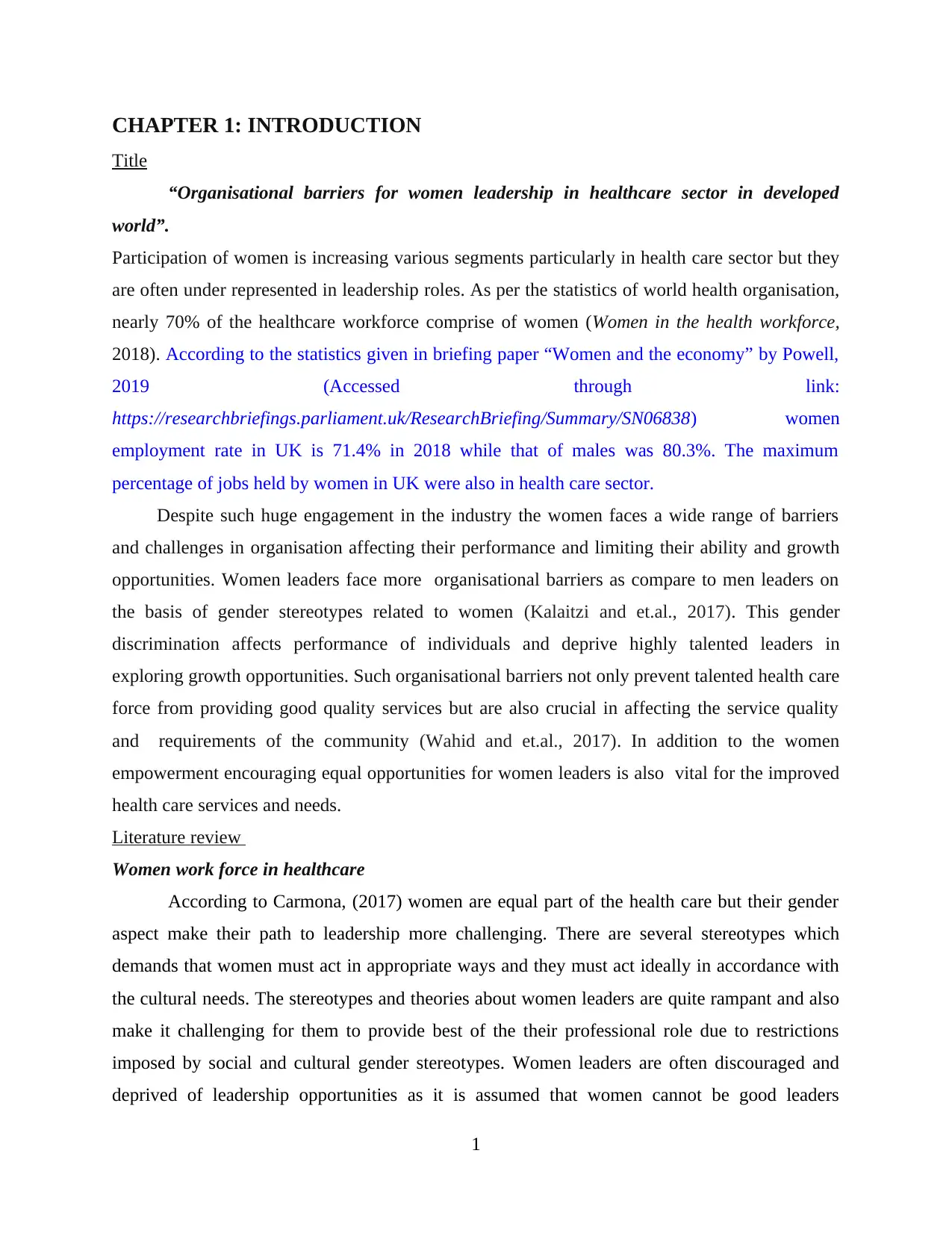
CHAPTER 1: INTRODUCTION
Title
“Organisational barriers for women leadership in healthcare sector in developed
world”.
Participation of women is increasing various segments particularly in health care sector but they
are often under represented in leadership roles. As per the statistics of world health organisation,
nearly 70% of the healthcare workforce comprise of women (Women in the health workforce,
2018). According to the statistics given in briefing paper “Women and the economy” by Powell,
2019 (Accessed through link:
https://researchbriefings.parliament.uk/ResearchBriefing/Summary/SN06838) women
employment rate in UK is 71.4% in 2018 while that of males was 80.3%. The maximum
percentage of jobs held by women in UK were also in health care sector.
Despite such huge engagement in the industry the women faces a wide range of barriers
and challenges in organisation affecting their performance and limiting their ability and growth
opportunities. Women leaders face more organisational barriers as compare to men leaders on
the basis of gender stereotypes related to women (Kalaitzi and et.al., 2017). This gender
discrimination affects performance of individuals and deprive highly talented leaders in
exploring growth opportunities. Such organisational barriers not only prevent talented health care
force from providing good quality services but are also crucial in affecting the service quality
and requirements of the community (Wahid and et.al., 2017). In addition to the women
empowerment encouraging equal opportunities for women leaders is also vital for the improved
health care services and needs.
Literature review
Women work force in healthcare
According to Carmona, (2017) women are equal part of the health care but their gender
aspect make their path to leadership more challenging. There are several stereotypes which
demands that women must act in appropriate ways and they must act ideally in accordance with
the cultural needs. The stereotypes and theories about women leaders are quite rampant and also
make it challenging for them to provide best of the their professional role due to restrictions
imposed by social and cultural gender stereotypes. Women leaders are often discouraged and
deprived of leadership opportunities as it is assumed that women cannot be good leaders
1
Title
“Organisational barriers for women leadership in healthcare sector in developed
world”.
Participation of women is increasing various segments particularly in health care sector but they
are often under represented in leadership roles. As per the statistics of world health organisation,
nearly 70% of the healthcare workforce comprise of women (Women in the health workforce,
2018). According to the statistics given in briefing paper “Women and the economy” by Powell,
2019 (Accessed through link:
https://researchbriefings.parliament.uk/ResearchBriefing/Summary/SN06838) women
employment rate in UK is 71.4% in 2018 while that of males was 80.3%. The maximum
percentage of jobs held by women in UK were also in health care sector.
Despite such huge engagement in the industry the women faces a wide range of barriers
and challenges in organisation affecting their performance and limiting their ability and growth
opportunities. Women leaders face more organisational barriers as compare to men leaders on
the basis of gender stereotypes related to women (Kalaitzi and et.al., 2017). This gender
discrimination affects performance of individuals and deprive highly talented leaders in
exploring growth opportunities. Such organisational barriers not only prevent talented health care
force from providing good quality services but are also crucial in affecting the service quality
and requirements of the community (Wahid and et.al., 2017). In addition to the women
empowerment encouraging equal opportunities for women leaders is also vital for the improved
health care services and needs.
Literature review
Women work force in healthcare
According to Carmona, (2017) women are equal part of the health care but their gender
aspect make their path to leadership more challenging. There are several stereotypes which
demands that women must act in appropriate ways and they must act ideally in accordance with
the cultural needs. The stereotypes and theories about women leaders are quite rampant and also
make it challenging for them to provide best of the their professional role due to restrictions
imposed by social and cultural gender stereotypes. Women leaders are often discouraged and
deprived of leadership opportunities as it is assumed that women cannot be good leaders
1
⊘ This is a preview!⊘
Do you want full access?
Subscribe today to unlock all pages.

Trusted by 1+ million students worldwide
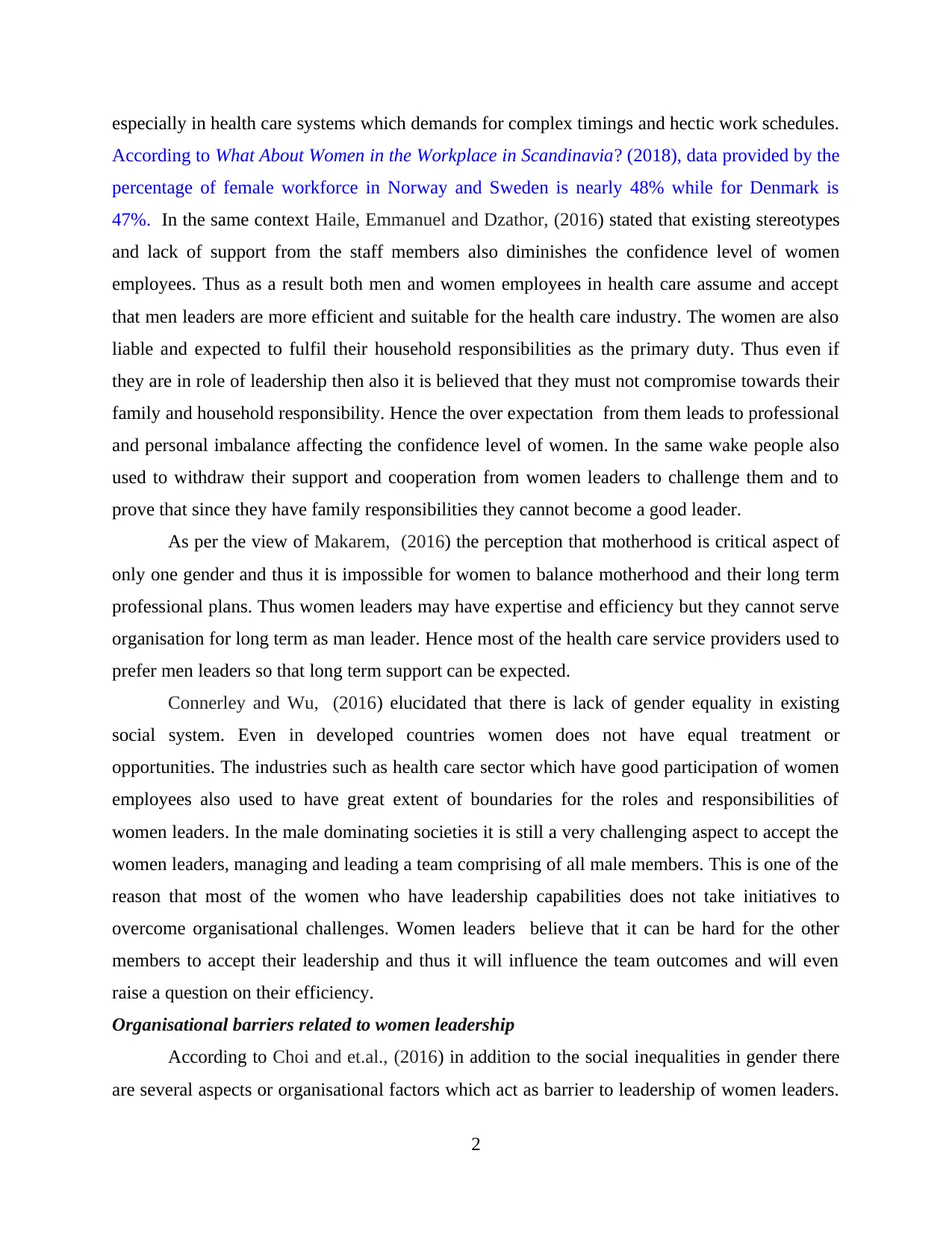
especially in health care systems which demands for complex timings and hectic work schedules.
According to What About Women in the Workplace in Scandinavia? (2018), data provided by the
percentage of female workforce in Norway and Sweden is nearly 48% while for Denmark is
47%. In the same context Haile, Emmanuel and Dzathor, (2016) stated that existing stereotypes
and lack of support from the staff members also diminishes the confidence level of women
employees. Thus as a result both men and women employees in health care assume and accept
that men leaders are more efficient and suitable for the health care industry. The women are also
liable and expected to fulfil their household responsibilities as the primary duty. Thus even if
they are in role of leadership then also it is believed that they must not compromise towards their
family and household responsibility. Hence the over expectation from them leads to professional
and personal imbalance affecting the confidence level of women. In the same wake people also
used to withdraw their support and cooperation from women leaders to challenge them and to
prove that since they have family responsibilities they cannot become a good leader.
As per the view of Makarem, (2016) the perception that motherhood is critical aspect of
only one gender and thus it is impossible for women to balance motherhood and their long term
professional plans. Thus women leaders may have expertise and efficiency but they cannot serve
organisation for long term as man leader. Hence most of the health care service providers used to
prefer men leaders so that long term support can be expected.
Connerley and Wu, (2016) elucidated that there is lack of gender equality in existing
social system. Even in developed countries women does not have equal treatment or
opportunities. The industries such as health care sector which have good participation of women
employees also used to have great extent of boundaries for the roles and responsibilities of
women leaders. In the male dominating societies it is still a very challenging aspect to accept the
women leaders, managing and leading a team comprising of all male members. This is one of the
reason that most of the women who have leadership capabilities does not take initiatives to
overcome organisational challenges. Women leaders believe that it can be hard for the other
members to accept their leadership and thus it will influence the team outcomes and will even
raise a question on their efficiency.
Organisational barriers related to women leadership
According to Choi and et.al., (2016) in addition to the social inequalities in gender there
are several aspects or organisational factors which act as barrier to leadership of women leaders.
2
According to What About Women in the Workplace in Scandinavia? (2018), data provided by the
percentage of female workforce in Norway and Sweden is nearly 48% while for Denmark is
47%. In the same context Haile, Emmanuel and Dzathor, (2016) stated that existing stereotypes
and lack of support from the staff members also diminishes the confidence level of women
employees. Thus as a result both men and women employees in health care assume and accept
that men leaders are more efficient and suitable for the health care industry. The women are also
liable and expected to fulfil their household responsibilities as the primary duty. Thus even if
they are in role of leadership then also it is believed that they must not compromise towards their
family and household responsibility. Hence the over expectation from them leads to professional
and personal imbalance affecting the confidence level of women. In the same wake people also
used to withdraw their support and cooperation from women leaders to challenge them and to
prove that since they have family responsibilities they cannot become a good leader.
As per the view of Makarem, (2016) the perception that motherhood is critical aspect of
only one gender and thus it is impossible for women to balance motherhood and their long term
professional plans. Thus women leaders may have expertise and efficiency but they cannot serve
organisation for long term as man leader. Hence most of the health care service providers used to
prefer men leaders so that long term support can be expected.
Connerley and Wu, (2016) elucidated that there is lack of gender equality in existing
social system. Even in developed countries women does not have equal treatment or
opportunities. The industries such as health care sector which have good participation of women
employees also used to have great extent of boundaries for the roles and responsibilities of
women leaders. In the male dominating societies it is still a very challenging aspect to accept the
women leaders, managing and leading a team comprising of all male members. This is one of the
reason that most of the women who have leadership capabilities does not take initiatives to
overcome organisational challenges. Women leaders believe that it can be hard for the other
members to accept their leadership and thus it will influence the team outcomes and will even
raise a question on their efficiency.
Organisational barriers related to women leadership
According to Choi and et.al., (2016) in addition to the social inequalities in gender there
are several aspects or organisational factors which act as barrier to leadership of women leaders.
2
Paraphrase This Document
Need a fresh take? Get an instant paraphrase of this document with our AI Paraphraser
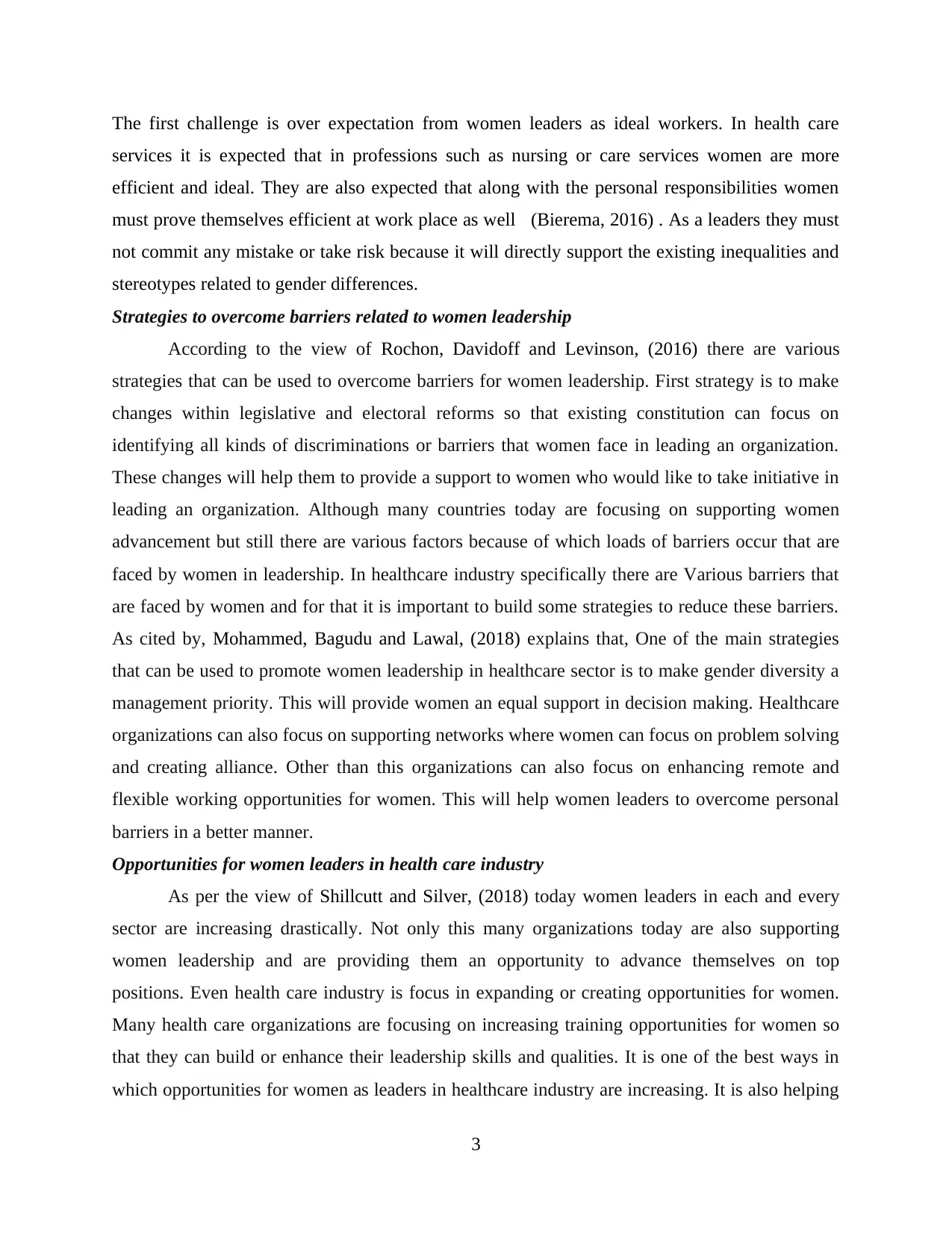
The first challenge is over expectation from women leaders as ideal workers. In health care
services it is expected that in professions such as nursing or care services women are more
efficient and ideal. They are also expected that along with the personal responsibilities women
must prove themselves efficient at work place as well (Bierema, 2016) . As a leaders they must
not commit any mistake or take risk because it will directly support the existing inequalities and
stereotypes related to gender differences.
Strategies to overcome barriers related to women leadership
According to the view of Rochon, Davidoff and Levinson, (2016) there are various
strategies that can be used to overcome barriers for women leadership. First strategy is to make
changes within legislative and electoral reforms so that existing constitution can focus on
identifying all kinds of discriminations or barriers that women face in leading an organization.
These changes will help them to provide a support to women who would like to take initiative in
leading an organization. Although many countries today are focusing on supporting women
advancement but still there are various factors because of which loads of barriers occur that are
faced by women in leadership. In healthcare industry specifically there are Various barriers that
are faced by women and for that it is important to build some strategies to reduce these barriers.
As cited by, Mohammed, Bagudu and Lawal, (2018) explains that, One of the main strategies
that can be used to promote women leadership in healthcare sector is to make gender diversity a
management priority. This will provide women an equal support in decision making. Healthcare
organizations can also focus on supporting networks where women can focus on problem solving
and creating alliance. Other than this organizations can also focus on enhancing remote and
flexible working opportunities for women. This will help women leaders to overcome personal
barriers in a better manner.
Opportunities for women leaders in health care industry
As per the view of Shillcutt and Silver, (2018) today women leaders in each and every
sector are increasing drastically. Not only this many organizations today are also supporting
women leadership and are providing them an opportunity to advance themselves on top
positions. Even health care industry is focus in expanding or creating opportunities for women.
Many health care organizations are focusing on increasing training opportunities for women so
that they can build or enhance their leadership skills and qualities. It is one of the best ways in
which opportunities for women as leaders in healthcare industry are increasing. It is also helping
3
services it is expected that in professions such as nursing or care services women are more
efficient and ideal. They are also expected that along with the personal responsibilities women
must prove themselves efficient at work place as well (Bierema, 2016) . As a leaders they must
not commit any mistake or take risk because it will directly support the existing inequalities and
stereotypes related to gender differences.
Strategies to overcome barriers related to women leadership
According to the view of Rochon, Davidoff and Levinson, (2016) there are various
strategies that can be used to overcome barriers for women leadership. First strategy is to make
changes within legislative and electoral reforms so that existing constitution can focus on
identifying all kinds of discriminations or barriers that women face in leading an organization.
These changes will help them to provide a support to women who would like to take initiative in
leading an organization. Although many countries today are focusing on supporting women
advancement but still there are various factors because of which loads of barriers occur that are
faced by women in leadership. In healthcare industry specifically there are Various barriers that
are faced by women and for that it is important to build some strategies to reduce these barriers.
As cited by, Mohammed, Bagudu and Lawal, (2018) explains that, One of the main strategies
that can be used to promote women leadership in healthcare sector is to make gender diversity a
management priority. This will provide women an equal support in decision making. Healthcare
organizations can also focus on supporting networks where women can focus on problem solving
and creating alliance. Other than this organizations can also focus on enhancing remote and
flexible working opportunities for women. This will help women leaders to overcome personal
barriers in a better manner.
Opportunities for women leaders in health care industry
As per the view of Shillcutt and Silver, (2018) today women leaders in each and every
sector are increasing drastically. Not only this many organizations today are also supporting
women leadership and are providing them an opportunity to advance themselves on top
positions. Even health care industry is focus in expanding or creating opportunities for women.
Many health care organizations are focusing on increasing training opportunities for women so
that they can build or enhance their leadership skills and qualities. It is one of the best ways in
which opportunities for women as leaders in healthcare industry are increasing. It is also helping
3
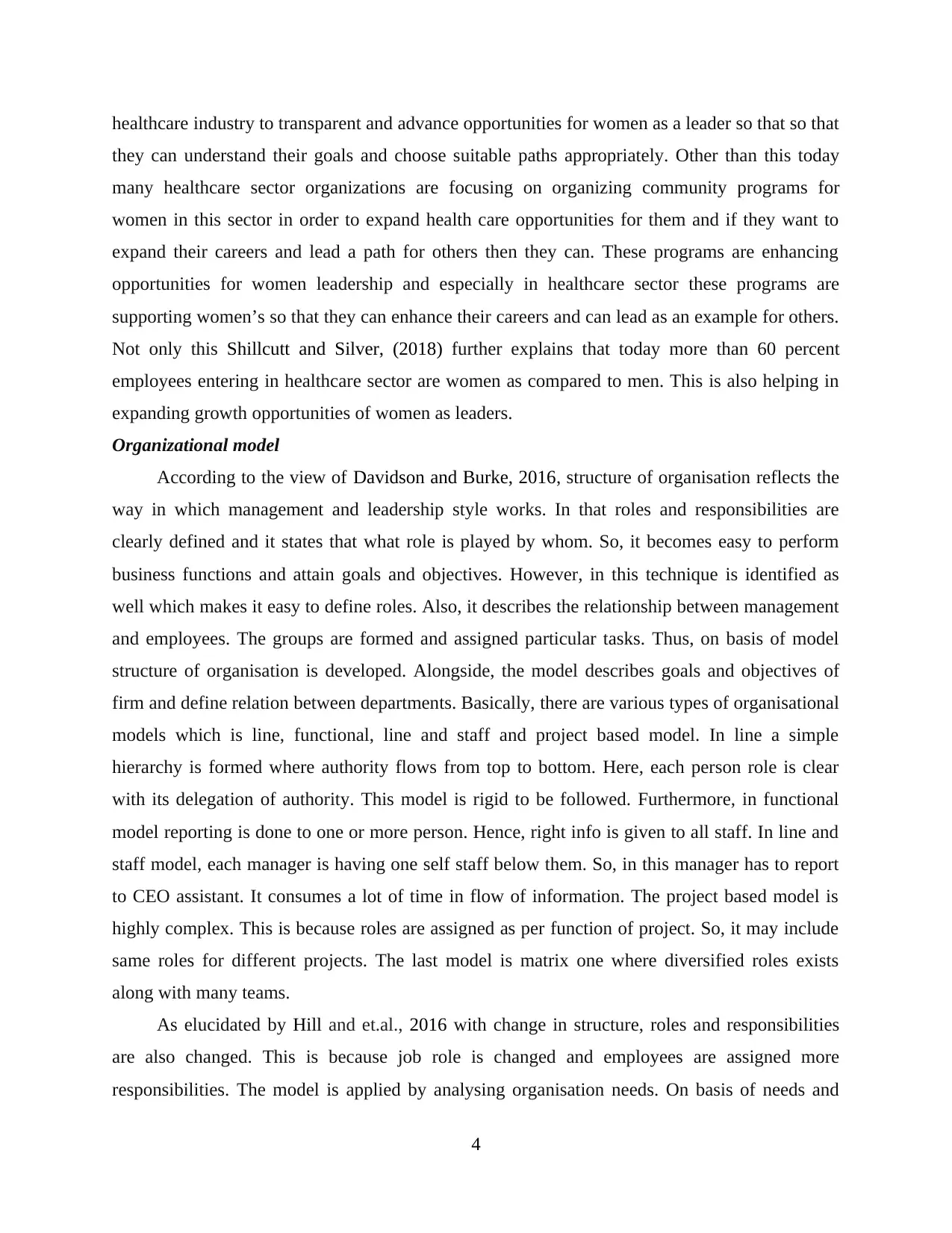
healthcare industry to transparent and advance opportunities for women as a leader so that so that
they can understand their goals and choose suitable paths appropriately. Other than this today
many healthcare sector organizations are focusing on organizing community programs for
women in this sector in order to expand health care opportunities for them and if they want to
expand their careers and lead a path for others then they can. These programs are enhancing
opportunities for women leadership and especially in healthcare sector these programs are
supporting women’s so that they can enhance their careers and can lead as an example for others.
Not only this Shillcutt and Silver, (2018) further explains that today more than 60 percent
employees entering in healthcare sector are women as compared to men. This is also helping in
expanding growth opportunities of women as leaders.
Organizational model
According to the view of Davidson and Burke, 2016, structure of organisation reflects the
way in which management and leadership style works. In that roles and responsibilities are
clearly defined and it states that what role is played by whom. So, it becomes easy to perform
business functions and attain goals and objectives. However, in this technique is identified as
well which makes it easy to define roles. Also, it describes the relationship between management
and employees. The groups are formed and assigned particular tasks. Thus, on basis of model
structure of organisation is developed. Alongside, the model describes goals and objectives of
firm and define relation between departments. Basically, there are various types of organisational
models which is line, functional, line and staff and project based model. In line a simple
hierarchy is formed where authority flows from top to bottom. Here, each person role is clear
with its delegation of authority. This model is rigid to be followed. Furthermore, in functional
model reporting is done to one or more person. Hence, right info is given to all staff. In line and
staff model, each manager is having one self staff below them. So, in this manager has to report
to CEO assistant. It consumes a lot of time in flow of information. The project based model is
highly complex. This is because roles are assigned as per function of project. So, it may include
same roles for different projects. The last model is matrix one where diversified roles exists
along with many teams.
As elucidated by Hill and et.al., 2016 with change in structure, roles and responsibilities
are also changed. This is because job role is changed and employees are assigned more
responsibilities. The model is applied by analysing organisation needs. On basis of needs and
4
they can understand their goals and choose suitable paths appropriately. Other than this today
many healthcare sector organizations are focusing on organizing community programs for
women in this sector in order to expand health care opportunities for them and if they want to
expand their careers and lead a path for others then they can. These programs are enhancing
opportunities for women leadership and especially in healthcare sector these programs are
supporting women’s so that they can enhance their careers and can lead as an example for others.
Not only this Shillcutt and Silver, (2018) further explains that today more than 60 percent
employees entering in healthcare sector are women as compared to men. This is also helping in
expanding growth opportunities of women as leaders.
Organizational model
According to the view of Davidson and Burke, 2016, structure of organisation reflects the
way in which management and leadership style works. In that roles and responsibilities are
clearly defined and it states that what role is played by whom. So, it becomes easy to perform
business functions and attain goals and objectives. However, in this technique is identified as
well which makes it easy to define roles. Also, it describes the relationship between management
and employees. The groups are formed and assigned particular tasks. Thus, on basis of model
structure of organisation is developed. Alongside, the model describes goals and objectives of
firm and define relation between departments. Basically, there are various types of organisational
models which is line, functional, line and staff and project based model. In line a simple
hierarchy is formed where authority flows from top to bottom. Here, each person role is clear
with its delegation of authority. This model is rigid to be followed. Furthermore, in functional
model reporting is done to one or more person. Hence, right info is given to all staff. In line and
staff model, each manager is having one self staff below them. So, in this manager has to report
to CEO assistant. It consumes a lot of time in flow of information. The project based model is
highly complex. This is because roles are assigned as per function of project. So, it may include
same roles for different projects. The last model is matrix one where diversified roles exists
along with many teams.
As elucidated by Hill and et.al., 2016 with change in structure, roles and responsibilities
are also changed. This is because job role is changed and employees are assigned more
responsibilities. The model is applied by analysing organisation needs. On basis of needs and
4
⊘ This is a preview!⊘
Do you want full access?
Subscribe today to unlock all pages.

Trusted by 1+ million students worldwide

goals, structure is developed. It enables in attaining those in effective team. but in recent times,
there is many trends occurred in model. It has highly impacted on small business structure. They
have to assign roles on basis of goals. Apart from it, many small companies are not able to form
a structure. They are working on side by side business plan. The floor plans are opened where
people are assigned roles on basis of their skills and abilities.
Similarly, Lifearc is a medical research council. Its structure is formed on basis of model.
The roles are clearly defined. In that Dr. John is chairman of council. Below him, many
researchers and scientist are working in medical field. Each one is assigned distinct roles on basis
of their skills and capabilities (Kalaitzi and et.al., 2017). With this women role were specified
and they lead a team. So, small teams were formed with allocated tasks. In this way information
was passed in efficient way. In this organisation Melanie Lee is women leader who have
successfully leading team. She follows democratic style which enabled in involving all staff to
participate in decision making.
Literature gaps
A vast range of studies have been conducted on issues highlighting the gender
discrimination in health care and barriers to women leadership. The previous literature sources
mainly emphasis on reasons which affects the women leadership in health care, however a very
limited attention is paid to impact of such gender bias and its impact on health care. This
research study will not only identify the organisational barriers but will also focus on the
solutions to address such barriers (Ahmed and et.al., 2016). Further the study will also evaluate
the role of such organisational barriers in influencing the quality of health care services and
progress of women empowerment in developed countries which is not determined in the
previous studies or literature sources.
Aim
To analyse the various organisational barriers for women leadership in healthcare sector
in developed world.
Objectives
To understand the current status of women leadership in healthcare sectors.
To evaluate challenges faced by women leaders in healthcare
To determine organisational barriers for women leaders in developed world within health
care industry.
5
there is many trends occurred in model. It has highly impacted on small business structure. They
have to assign roles on basis of goals. Apart from it, many small companies are not able to form
a structure. They are working on side by side business plan. The floor plans are opened where
people are assigned roles on basis of their skills and abilities.
Similarly, Lifearc is a medical research council. Its structure is formed on basis of model.
The roles are clearly defined. In that Dr. John is chairman of council. Below him, many
researchers and scientist are working in medical field. Each one is assigned distinct roles on basis
of their skills and capabilities (Kalaitzi and et.al., 2017). With this women role were specified
and they lead a team. So, small teams were formed with allocated tasks. In this way information
was passed in efficient way. In this organisation Melanie Lee is women leader who have
successfully leading team. She follows democratic style which enabled in involving all staff to
participate in decision making.
Literature gaps
A vast range of studies have been conducted on issues highlighting the gender
discrimination in health care and barriers to women leadership. The previous literature sources
mainly emphasis on reasons which affects the women leadership in health care, however a very
limited attention is paid to impact of such gender bias and its impact on health care. This
research study will not only identify the organisational barriers but will also focus on the
solutions to address such barriers (Ahmed and et.al., 2016). Further the study will also evaluate
the role of such organisational barriers in influencing the quality of health care services and
progress of women empowerment in developed countries which is not determined in the
previous studies or literature sources.
Aim
To analyse the various organisational barriers for women leadership in healthcare sector
in developed world.
Objectives
To understand the current status of women leadership in healthcare sectors.
To evaluate challenges faced by women leaders in healthcare
To determine organisational barriers for women leaders in developed world within health
care industry.
5
Paraphrase This Document
Need a fresh take? Get an instant paraphrase of this document with our AI Paraphraser
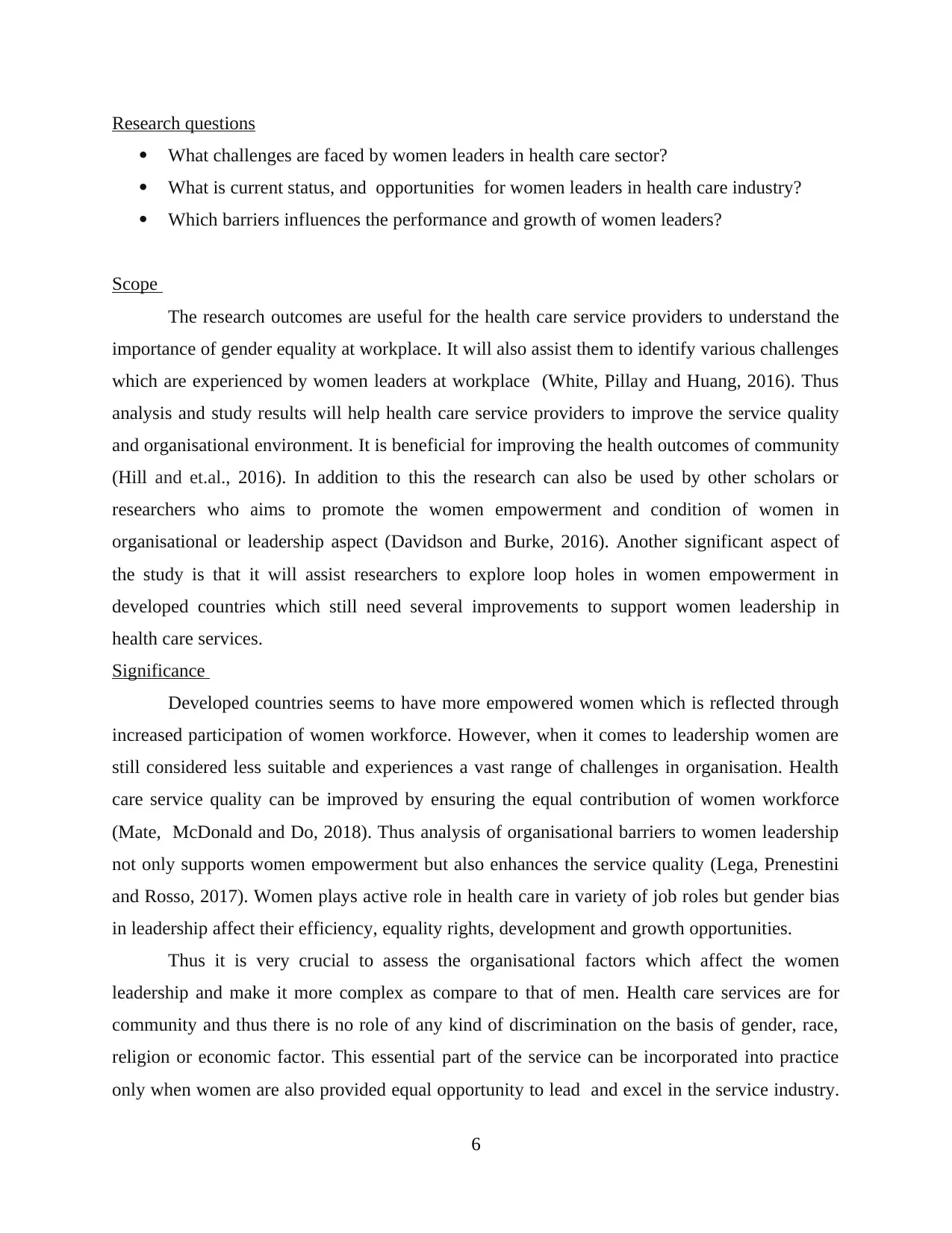
Research questions
What challenges are faced by women leaders in health care sector?
What is current status, and opportunities for women leaders in health care industry?
Which barriers influences the performance and growth of women leaders?
Scope
The research outcomes are useful for the health care service providers to understand the
importance of gender equality at workplace. It will also assist them to identify various challenges
which are experienced by women leaders at workplace (White, Pillay and Huang, 2016). Thus
analysis and study results will help health care service providers to improve the service quality
and organisational environment. It is beneficial for improving the health outcomes of community
(Hill and et.al., 2016). In addition to this the research can also be used by other scholars or
researchers who aims to promote the women empowerment and condition of women in
organisational or leadership aspect (Davidson and Burke, 2016). Another significant aspect of
the study is that it will assist researchers to explore loop holes in women empowerment in
developed countries which still need several improvements to support women leadership in
health care services.
Significance
Developed countries seems to have more empowered women which is reflected through
increased participation of women workforce. However, when it comes to leadership women are
still considered less suitable and experiences a vast range of challenges in organisation. Health
care service quality can be improved by ensuring the equal contribution of women workforce
(Mate, McDonald and Do, 2018). Thus analysis of organisational barriers to women leadership
not only supports women empowerment but also enhances the service quality (Lega, Prenestini
and Rosso, 2017). Women plays active role in health care in variety of job roles but gender bias
in leadership affect their efficiency, equality rights, development and growth opportunities.
Thus it is very crucial to assess the organisational factors which affect the women
leadership and make it more complex as compare to that of men. Health care services are for
community and thus there is no role of any kind of discrimination on the basis of gender, race,
religion or economic factor. This essential part of the service can be incorporated into practice
only when women are also provided equal opportunity to lead and excel in the service industry.
6
What challenges are faced by women leaders in health care sector?
What is current status, and opportunities for women leaders in health care industry?
Which barriers influences the performance and growth of women leaders?
Scope
The research outcomes are useful for the health care service providers to understand the
importance of gender equality at workplace. It will also assist them to identify various challenges
which are experienced by women leaders at workplace (White, Pillay and Huang, 2016). Thus
analysis and study results will help health care service providers to improve the service quality
and organisational environment. It is beneficial for improving the health outcomes of community
(Hill and et.al., 2016). In addition to this the research can also be used by other scholars or
researchers who aims to promote the women empowerment and condition of women in
organisational or leadership aspect (Davidson and Burke, 2016). Another significant aspect of
the study is that it will assist researchers to explore loop holes in women empowerment in
developed countries which still need several improvements to support women leadership in
health care services.
Significance
Developed countries seems to have more empowered women which is reflected through
increased participation of women workforce. However, when it comes to leadership women are
still considered less suitable and experiences a vast range of challenges in organisation. Health
care service quality can be improved by ensuring the equal contribution of women workforce
(Mate, McDonald and Do, 2018). Thus analysis of organisational barriers to women leadership
not only supports women empowerment but also enhances the service quality (Lega, Prenestini
and Rosso, 2017). Women plays active role in health care in variety of job roles but gender bias
in leadership affect their efficiency, equality rights, development and growth opportunities.
Thus it is very crucial to assess the organisational factors which affect the women
leadership and make it more complex as compare to that of men. Health care services are for
community and thus there is no role of any kind of discrimination on the basis of gender, race,
religion or economic factor. This essential part of the service can be incorporated into practice
only when women are also provided equal opportunity to lead and excel in the service industry.
6
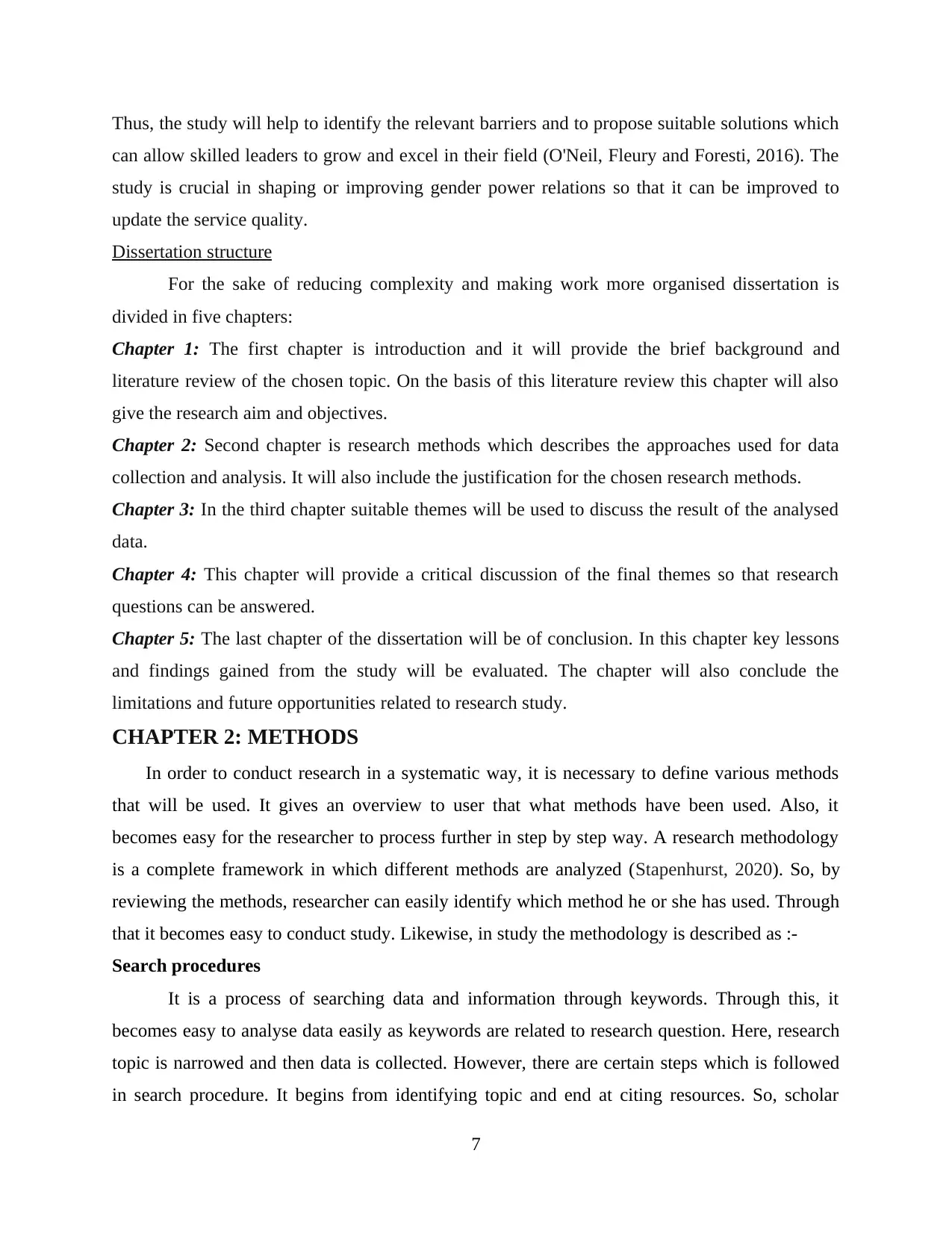
Thus, the study will help to identify the relevant barriers and to propose suitable solutions which
can allow skilled leaders to grow and excel in their field (O'Neil, Fleury and Foresti, 2016). The
study is crucial in shaping or improving gender power relations so that it can be improved to
update the service quality.
Dissertation structure
For the sake of reducing complexity and making work more organised dissertation is
divided in five chapters:
Chapter 1: The first chapter is introduction and it will provide the brief background and
literature review of the chosen topic. On the basis of this literature review this chapter will also
give the research aim and objectives.
Chapter 2: Second chapter is research methods which describes the approaches used for data
collection and analysis. It will also include the justification for the chosen research methods.
Chapter 3: In the third chapter suitable themes will be used to discuss the result of the analysed
data.
Chapter 4: This chapter will provide a critical discussion of the final themes so that research
questions can be answered.
Chapter 5: The last chapter of the dissertation will be of conclusion. In this chapter key lessons
and findings gained from the study will be evaluated. The chapter will also conclude the
limitations and future opportunities related to research study.
CHAPTER 2: METHODS
In order to conduct research in a systematic way, it is necessary to define various methods
that will be used. It gives an overview to user that what methods have been used. Also, it
becomes easy for the researcher to process further in step by step way. A research methodology
is a complete framework in which different methods are analyzed (Stapenhurst, 2020). So, by
reviewing the methods, researcher can easily identify which method he or she has used. Through
that it becomes easy to conduct study. Likewise, in study the methodology is described as :-
Search procedures
It is a process of searching data and information through keywords. Through this, it
becomes easy to analyse data easily as keywords are related to research question. Here, research
topic is narrowed and then data is collected. However, there are certain steps which is followed
in search procedure. It begins from identifying topic and end at citing resources. So, scholar
7
can allow skilled leaders to grow and excel in their field (O'Neil, Fleury and Foresti, 2016). The
study is crucial in shaping or improving gender power relations so that it can be improved to
update the service quality.
Dissertation structure
For the sake of reducing complexity and making work more organised dissertation is
divided in five chapters:
Chapter 1: The first chapter is introduction and it will provide the brief background and
literature review of the chosen topic. On the basis of this literature review this chapter will also
give the research aim and objectives.
Chapter 2: Second chapter is research methods which describes the approaches used for data
collection and analysis. It will also include the justification for the chosen research methods.
Chapter 3: In the third chapter suitable themes will be used to discuss the result of the analysed
data.
Chapter 4: This chapter will provide a critical discussion of the final themes so that research
questions can be answered.
Chapter 5: The last chapter of the dissertation will be of conclusion. In this chapter key lessons
and findings gained from the study will be evaluated. The chapter will also conclude the
limitations and future opportunities related to research study.
CHAPTER 2: METHODS
In order to conduct research in a systematic way, it is necessary to define various methods
that will be used. It gives an overview to user that what methods have been used. Also, it
becomes easy for the researcher to process further in step by step way. A research methodology
is a complete framework in which different methods are analyzed (Stapenhurst, 2020). So, by
reviewing the methods, researcher can easily identify which method he or she has used. Through
that it becomes easy to conduct study. Likewise, in study the methodology is described as :-
Search procedures
It is a process of searching data and information through keywords. Through this, it
becomes easy to analyse data easily as keywords are related to research question. Here, research
topic is narrowed and then data is collected. However, there are certain steps which is followed
in search procedure. It begins from identifying topic and end at citing resources. So, scholar
7
⊘ This is a preview!⊘
Do you want full access?
Subscribe today to unlock all pages.

Trusted by 1+ million students worldwide

collect secondary data and then gather relevant and crucial info only through it. If keyword is
determined than it is easy to analyse whether data is relevant in that particular article or not.
Moreover, it is easy to search articles through keywords (Sharif and et.al., 2020). For present
study, the keywords identified are :-
Organisational barriers for women leadership in healthcare sector.
Moreover, scholar will search database such as Proquest, EBSCO, etc. to gather data and
information. In that keywords will be used such as barriers, leadership, challenges, etc.
Furthermore, inclusion and exclusion criteria is set in search procedure. Inclusion is the
characteristics of topic which is to be included in study whereas exclusion refers to those that are
to be excluded from study. By this it becomes easy to select articles and analyze data included in
it. However, time is saved as well as info is easily obtained. It also saves cost of research. They
are defined below :-
Inclusion criteria
The review included studies related to organizational barriers in women leadership in
health care. Also, challenges faced by women as a leader. Moreover, studies conducted in health
care sector will be considered. Only articles of English language will be included.
Exclusion criteria
The articles will be excluded from study:
Before year 2015
Challenges in leadership
Studies conducted in other sector or area.
Researcher done in specific gender, situation, age and many more.
Studies in other languages such as French.
Inclusion and exclusion criteria – research design
Studies will be excluded if there is not particular research design used.
Mixed method will also be excluded.
Systematic review method will be excluded as well.
Included studies – qualitative
Questionnaire
Survey method
Interview
8
determined than it is easy to analyse whether data is relevant in that particular article or not.
Moreover, it is easy to search articles through keywords (Sharif and et.al., 2020). For present
study, the keywords identified are :-
Organisational barriers for women leadership in healthcare sector.
Moreover, scholar will search database such as Proquest, EBSCO, etc. to gather data and
information. In that keywords will be used such as barriers, leadership, challenges, etc.
Furthermore, inclusion and exclusion criteria is set in search procedure. Inclusion is the
characteristics of topic which is to be included in study whereas exclusion refers to those that are
to be excluded from study. By this it becomes easy to select articles and analyze data included in
it. However, time is saved as well as info is easily obtained. It also saves cost of research. They
are defined below :-
Inclusion criteria
The review included studies related to organizational barriers in women leadership in
health care. Also, challenges faced by women as a leader. Moreover, studies conducted in health
care sector will be considered. Only articles of English language will be included.
Exclusion criteria
The articles will be excluded from study:
Before year 2015
Challenges in leadership
Studies conducted in other sector or area.
Researcher done in specific gender, situation, age and many more.
Studies in other languages such as French.
Inclusion and exclusion criteria – research design
Studies will be excluded if there is not particular research design used.
Mixed method will also be excluded.
Systematic review method will be excluded as well.
Included studies – qualitative
Questionnaire
Survey method
Interview
8
Paraphrase This Document
Need a fresh take? Get an instant paraphrase of this document with our AI Paraphraser
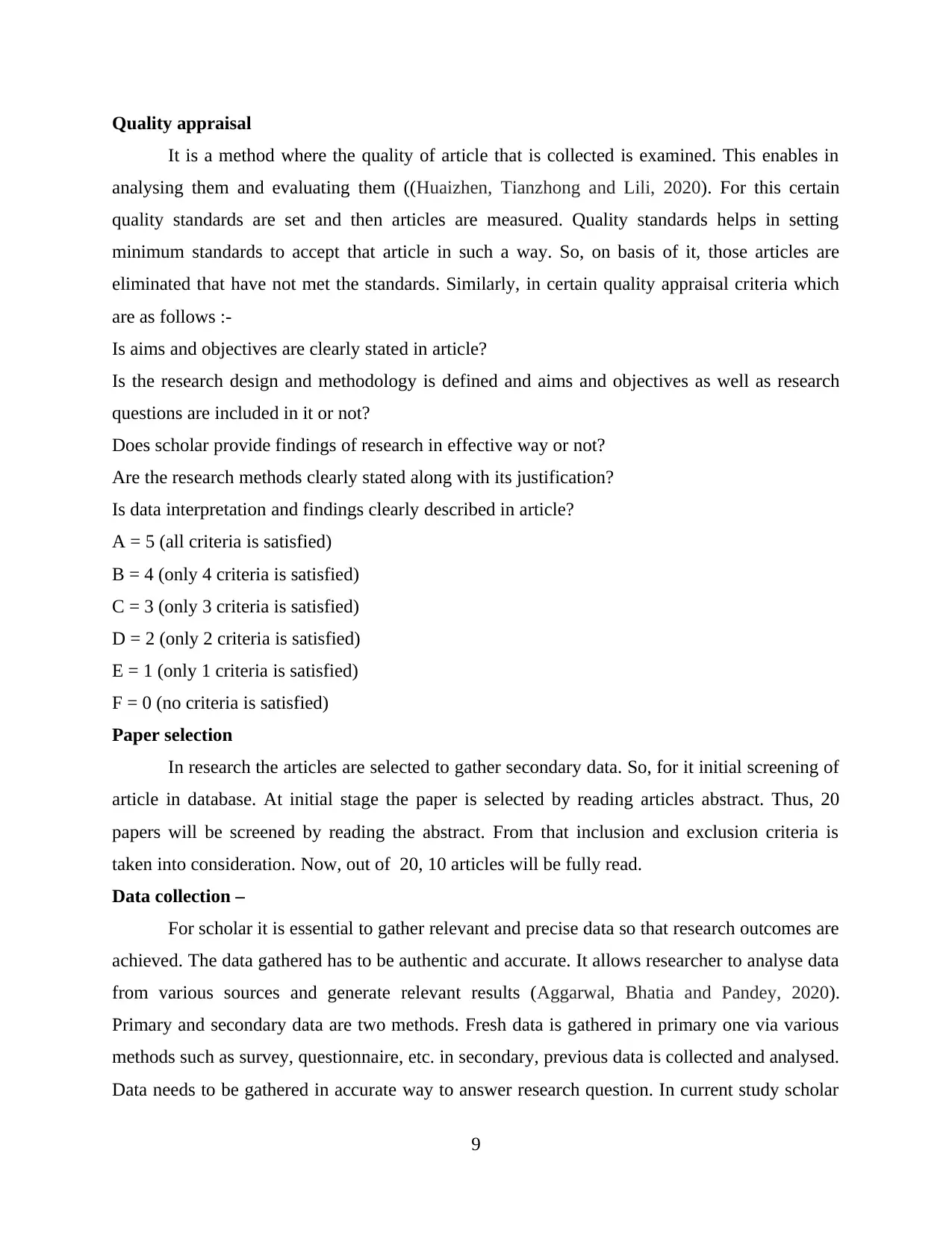
Quality appraisal
It is a method where the quality of article that is collected is examined. This enables in
analysing them and evaluating them ((Huaizhen, Tianzhong and Lili, 2020). For this certain
quality standards are set and then articles are measured. Quality standards helps in setting
minimum standards to accept that article in such a way. So, on basis of it, those articles are
eliminated that have not met the standards. Similarly, in certain quality appraisal criteria which
are as follows :-
Is aims and objectives are clearly stated in article?
Is the research design and methodology is defined and aims and objectives as well as research
questions are included in it or not?
Does scholar provide findings of research in effective way or not?
Are the research methods clearly stated along with its justification?
Is data interpretation and findings clearly described in article?
A = 5 (all criteria is satisfied)
B = 4 (only 4 criteria is satisfied)
C = 3 (only 3 criteria is satisfied)
D = 2 (only 2 criteria is satisfied)
E = 1 (only 1 criteria is satisfied)
F = 0 (no criteria is satisfied)
Paper selection
In research the articles are selected to gather secondary data. So, for it initial screening of
article in database. At initial stage the paper is selected by reading articles abstract. Thus, 20
papers will be screened by reading the abstract. From that inclusion and exclusion criteria is
taken into consideration. Now, out of 20, 10 articles will be fully read.
Data collection –
For scholar it is essential to gather relevant and precise data so that research outcomes are
achieved. The data gathered has to be authentic and accurate. It allows researcher to analyse data
from various sources and generate relevant results (Aggarwal, Bhatia and Pandey, 2020).
Primary and secondary data are two methods. Fresh data is gathered in primary one via various
methods such as survey, questionnaire, etc. in secondary, previous data is collected and analysed.
Data needs to be gathered in accurate way to answer research question. In current study scholar
9
It is a method where the quality of article that is collected is examined. This enables in
analysing them and evaluating them ((Huaizhen, Tianzhong and Lili, 2020). For this certain
quality standards are set and then articles are measured. Quality standards helps in setting
minimum standards to accept that article in such a way. So, on basis of it, those articles are
eliminated that have not met the standards. Similarly, in certain quality appraisal criteria which
are as follows :-
Is aims and objectives are clearly stated in article?
Is the research design and methodology is defined and aims and objectives as well as research
questions are included in it or not?
Does scholar provide findings of research in effective way or not?
Are the research methods clearly stated along with its justification?
Is data interpretation and findings clearly described in article?
A = 5 (all criteria is satisfied)
B = 4 (only 4 criteria is satisfied)
C = 3 (only 3 criteria is satisfied)
D = 2 (only 2 criteria is satisfied)
E = 1 (only 1 criteria is satisfied)
F = 0 (no criteria is satisfied)
Paper selection
In research the articles are selected to gather secondary data. So, for it initial screening of
article in database. At initial stage the paper is selected by reading articles abstract. Thus, 20
papers will be screened by reading the abstract. From that inclusion and exclusion criteria is
taken into consideration. Now, out of 20, 10 articles will be fully read.
Data collection –
For scholar it is essential to gather relevant and precise data so that research outcomes are
achieved. The data gathered has to be authentic and accurate. It allows researcher to analyse data
from various sources and generate relevant results (Aggarwal, Bhatia and Pandey, 2020).
Primary and secondary data are two methods. Fresh data is gathered in primary one via various
methods such as survey, questionnaire, etc. in secondary, previous data is collected and analysed.
Data needs to be gathered in accurate way to answer research question. In current study scholar
9
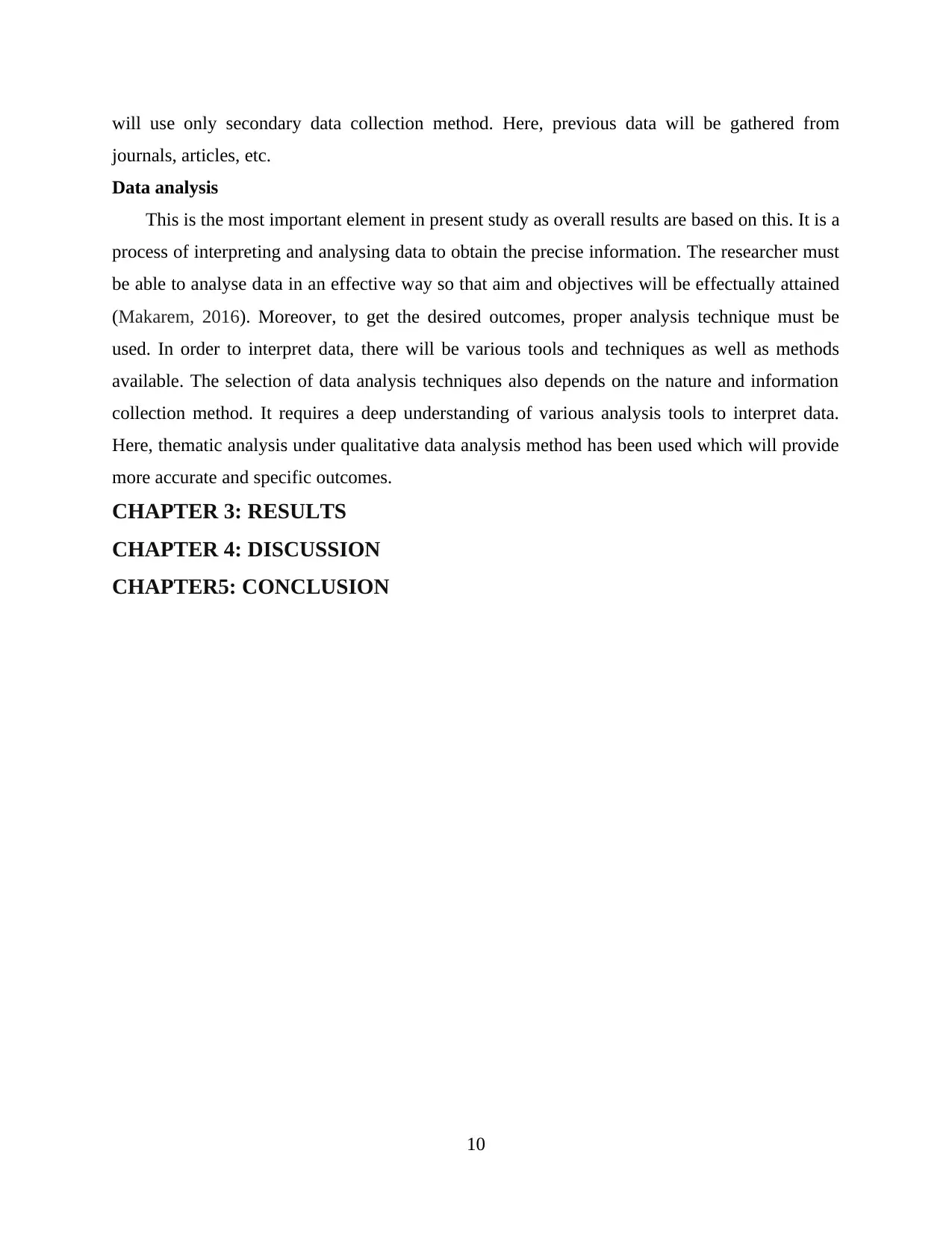
will use only secondary data collection method. Here, previous data will be gathered from
journals, articles, etc.
Data analysis
This is the most important element in present study as overall results are based on this. It is a
process of interpreting and analysing data to obtain the precise information. The researcher must
be able to analyse data in an effective way so that aim and objectives will be effectually attained
(Makarem, 2016). Moreover, to get the desired outcomes, proper analysis technique must be
used. In order to interpret data, there will be various tools and techniques as well as methods
available. The selection of data analysis techniques also depends on the nature and information
collection method. It requires a deep understanding of various analysis tools to interpret data.
Here, thematic analysis under qualitative data analysis method has been used which will provide
more accurate and specific outcomes.
CHAPTER 3: RESULTS
CHAPTER 4: DISCUSSION
CHAPTER5: CONCLUSION
10
journals, articles, etc.
Data analysis
This is the most important element in present study as overall results are based on this. It is a
process of interpreting and analysing data to obtain the precise information. The researcher must
be able to analyse data in an effective way so that aim and objectives will be effectually attained
(Makarem, 2016). Moreover, to get the desired outcomes, proper analysis technique must be
used. In order to interpret data, there will be various tools and techniques as well as methods
available. The selection of data analysis techniques also depends on the nature and information
collection method. It requires a deep understanding of various analysis tools to interpret data.
Here, thematic analysis under qualitative data analysis method has been used which will provide
more accurate and specific outcomes.
CHAPTER 3: RESULTS
CHAPTER 4: DISCUSSION
CHAPTER5: CONCLUSION
10
⊘ This is a preview!⊘
Do you want full access?
Subscribe today to unlock all pages.

Trusted by 1+ million students worldwide
1 out of 14
Related Documents
Your All-in-One AI-Powered Toolkit for Academic Success.
+13062052269
info@desklib.com
Available 24*7 on WhatsApp / Email
![[object Object]](/_next/static/media/star-bottom.7253800d.svg)
Unlock your academic potential
Copyright © 2020–2026 A2Z Services. All Rights Reserved. Developed and managed by ZUCOL.





